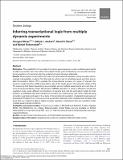Files in this item
Inferring transcriptional logic from multiple dynamic experiments
Item metadata
| dc.contributor.author | Minas, Giorgos | |
| dc.contributor.author | Jenkins, Dafyd J. | |
| dc.contributor.author | Rand, David A. | |
| dc.contributor.author | Finkenstädt, Bärbel | |
| dc.date.accessioned | 2018-08-03T09:30:09Z | |
| dc.date.available | 2018-08-03T09:30:09Z | |
| dc.date.issued | 2017-11-01 | |
| dc.identifier | 255153680 | |
| dc.identifier | 41a3c19f-69cd-411f-85aa-a422671dd3e7 | |
| dc.identifier | 85050446142 | |
| dc.identifier | 28666320 | |
| dc.identifier.citation | Minas , G , Jenkins , D J , Rand , D A & Finkenstädt , B 2017 , ' Inferring transcriptional logic from multiple dynamic experiments ' , Bioinformatics , vol. 33 , no. 21 , pp. 3437-3444 . https://doi.org/10.1093/bioinformatics/btx407 | en |
| dc.identifier.issn | 1367-4803 | |
| dc.identifier.other | ORCID: /0000-0001-7953-706X/work/47136662 | |
| dc.identifier.uri | https://hdl.handle.net/10023/15758 | |
| dc.description | This work was supported by the Biotechnology and Biological Sciences Research Council [BB/F005806/1, BB/K003097/1], the Engineering and Physical Sciences Research Council [EP/C544587/1 to DAR] and the European Union Seventh Framework Programme (FP7/2007-2013) under grant agreement n° 305564. | en |
| dc.description.abstract | Motivation: The availability of more data of dynamic gene expression under multiple experimental conditions provides new information that makes the key goal of identifying not only the transcriptional regulators of a gene but also the underlying logical structure attainable. Results: We propose a novel method for inferring transcriptional regulation using a simple, yet biologically interpretable, model to find the logic by which a set of candidate genes and their associated transcription factors (TFs) regulate the transcriptional process of a gene of interest. Our dynamic model links the mRNA transcription rate of the target gene to the activation states of the TFs assuming that these interactions are consistent across multiple experiments and over time. A trans-dimensional Markov Chain Monte Carlo (MCMC) algorithm is used to efficiently sample the regulatory logic under different combinations of parents and rank the estimated models by their posterior probabilities. We demonstrate and compare our methodology with other methods using simulation examples and apply it to a study of transcriptional regulation of selected target genes of Arabidopsis Thaliana from microarray time series data obtained under multiple biotic stresses. We show that our method is able to detect complex regulatory interactions that are consistent under multiple experimental conditions. Availability and implementation: Programs are written in MATLAB and Statistics Toolbox Release 2016b, The MathWorks, Inc., Natick, Massachusetts, United States and are available on GitHub https://github.com/giorgosminas/TRS and at http://www2.warwick.ac.uk/fac/sci/systemsbiology/research/software. | |
| dc.format.extent | 8 | |
| dc.format.extent | 791500 | |
| dc.language.iso | eng | |
| dc.relation.ispartof | Bioinformatics | en |
| dc.subject | QA Mathematics | en |
| dc.subject | QH301 Biology | en |
| dc.subject | Biochemistry | en |
| dc.subject | Molecular Biology | en |
| dc.subject | Computational Theory and Mathematics | en |
| dc.subject | Computer Science Applications | en |
| dc.subject | Computational Mathematics | en |
| dc.subject | Statistics and Probability | en |
| dc.subject | NDAS | en |
| dc.subject | BDC | en |
| dc.subject.lcc | QA | en |
| dc.subject.lcc | QH301 | en |
| dc.title | Inferring transcriptional logic from multiple dynamic experiments | en |
| dc.type | Journal article | en |
| dc.contributor.institution | University of St Andrews. Statistics | en |
| dc.identifier.doi | https://doi.org/10.1093/bioinformatics/btx407 | |
| dc.description.status | Peer reviewed | en |
| dc.identifier.url | https://academic.oup.com/bioinformatics/article/33/21/3437/3896986#supplementary-data | en |
This item appears in the following Collection(s)
Items in the St Andrews Research Repository are protected by copyright, with all rights reserved, unless otherwise indicated.

